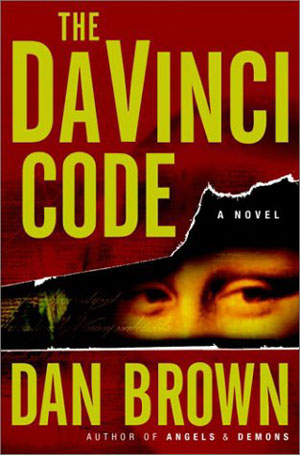Brown makes it clear at the outside in a page entitled 'FACT', that "All rituals, science, artwork and monuments in this novel are real." Nevertheless, a few of the more traditional scientists or science writers are already taking a swing at Brown for his impossible inventions and so-called junk science.
Although I cannot speak for many of the other elements in the book - Freemasonry, ancient symbols, alchemy or hidden keys - virtually all of his comments about physics, consciousness research, mind-over-matter experiments and intention are based on fact. Here's a quick guide.
* Katherine's lab uses random event generators. These machines, first developed by former Boeing physicist Helmut Schmidt, work like the space-age electronic equivalent of the toss of a coin. Most famously, REGs formed the basis of 25 years of consciousness research by Robert Jahn and psychologist Brenda Dunne at Princeton's PEAR lab. They developed sophisticated studies examining whether human minds could affect highly sensitive equipment governed by a random process.
*Her lab also uses CCD cameras that have photographed a faith healer's energy pouring from his hands.Dr. Gary Schwartz of the University of Arizona has a CCD camera-the kind of sensitive camera equipment that can photograph faint light from outer space. He uses it to photograph biophoton emissions-a tiny current of light that has been discovered to emanate from all living things. He has photographed an increase in this light flowing from the dominant hands of healers while 'sending' healing.
 * Katherine has a lab called the 'Cube', which is electromagnetically sealed so that human thought can't penetrate it. Within the Institute of Noetic Sciences in California, there is a lab with a one-ton solid steel, double-walled, electromagnetically shielded enclosure, which blocks out all electromagnetic energy. It's like the warmer equivalent of a meatpacking-plant refrigerator.
* Katherine has a lab called the 'Cube', which is electromagnetically sealed so that human thought can't penetrate it. Within the Institute of Noetic Sciences in California, there is a lab with a one-ton solid steel, double-walled, electromagnetically shielded enclosure, which blocks out all electromagnetic energy. It's like the warmer equivalent of a meatpacking-plant refrigerator.Katherine says her work was particularly inspired by:
* REG machines dotted all over the world, which recorded an effect on September 11, 2001, when the twin towers collapsed. Former Princeton PEAR researcher, psychologist Roger Nelson, runs the Global Consciousness Project, which has more than 50 REG machines running continuously all over the world. He compares changes in their random output during times of major catastrophic global events. He and his colleagues have studied hundreds of events and found that when people react with great joy or horror to breaking news, the machines seem to react as well. One of the biggest effects was seen during the events of 9/11.
* prayer groups that have healed people and also have affected REG machines. At least 150 studies of prayer and healing have shown positive results. Dr. Nelson's Global Consciousness Project has tracked measurable changes in REG machines after many global prayer events.
* the CIA, which ran remote viewing programs that bordered on ancient magic. These programs, run by CIA partnering with Stanford Research Institute's then directors, physicists Hal Puthoff and Russell Targ, conclusively demonstrated that even novices could see things beyond the reach of visual sense.
Katherine's mind-over-matter experiments have affected:
* the growth rate of plants. University of Arizona psychologist Gary Schwartz working with web-based intention experiments, ran six such successful experiments, and presented the results before the Society for Scientific Exploration in June 2008.
* the direction fish swim. Psychologist William Braud, then of the Mind Science Institute in Texas, ran such experiments in the 1970s.
* chemical reactions in one's own body. Hundreds of studies on biofeedback and the effects of intention on living systems carried out by scientists such as Braud or Marilyn Schlitz, president of the Institute of Noetic Sciences, show that intention can affect just about every system of the body, including the autonomic nervous system, biochemistry and even brain waves. The evidence also shows that when people send intention to others, elements of their biological processes, such as heart activity, breathing rate, blood flow and brain waves, begin operating in synch.
* Katherine carries out thought experiments on water, showing that she can change the design of the crystals, depending on whether she uses a positive or negative thought. These refer to the work of Dr. Masaru Emoto, author of The Hidden Messages in Water, who proposes that sending thoughts into water changes their crystalline patterns. Dean Radin of IONS successfully replicated Emoto's work under controlled conditions.
Lynne McTaggart, one of the preeminent spokespersons on consciousness and the new physics, is the award-winning journalist and author of five books, including the worldwide bestsellers The Field (Harper) and The Intention Experiment (Free Press). To find out more about her Intention Experiments and to participate in her global experiments, just register on her website:http://www.theintentionexperiment.com. |



 There are two protagonists, Robert Landon and Sophie Neveu -- Robert an expert on religious symbology and a Harvard professor, and Sophie a cryptologist and Parisian police agent. Both have skill sets, not by accident, which allow for great success at solving puzzles -- at least the type of puzzles presented here.
There are two protagonists, Robert Landon and Sophie Neveu -- Robert an expert on religious symbology and a Harvard professor, and Sophie a cryptologist and Parisian police agent. Both have skill sets, not by accident, which allow for great success at solving puzzles -- at least the type of puzzles presented here.


